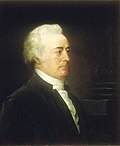| Jay Court | |
|---|---|
None ← | |
 | |
| October 19, 1789 – June 29, 1795 (5 years, 253 days) | |
| Seat | Old City Hall Philadelphia, Pennsylvania |
| No. of positions | 6 |
| Jay Court decisions | |
 | |
The Jay Court refers to the Supreme Court of the United States from 1789 to 1795, when John Jay served as the first Chief Justice of the United States. Jay served as Chief Justice until his resignation, at which point John Rutledge took office as a recess appointment. The Supreme Court was established in Article III of the United States Constitution, but the workings of the federal court system were largely laid out by the Judiciary Act of 1789, which established a six-member Supreme Court, composed of one Chief Justice and five Associate Justices. As the first President, George Washington was responsible for appointing the entire Supreme Court. The act also created thirteen judicial districts, along with district courts and circuit courts for each district.
Contents
The Court held its inaugural session on February 2, 1790, at the Royal Exchange in New York City. However, with no cases on the docket and little pressing business, the term lasted for only eight days. [1] It was not until August 1791 that the Court issued its first decision. [2] That same year, the Court moved with the rest of the federal government to Philadelphia.
The Court's business through its first three years primarily involved the establishment of rules and procedure; reading of commissions and admission of attorneys to the bar; and the Justices' duties in circuit riding, to preside over cases in the circuit courts of the various federal judicial districts. [3] It heard only four cases during Jay's chief justiceship.
During his tenure, Jay established an early precedent for the Court's independence in 1790, when Treasury Secretary Alexander Hamilton wrote to him requesting an advisory opinion on proposed legislation supported by the president. Jay replied that the Court's business was restricted to ruling on the constitutionality of cases being tried before it and refused to allow it to take a position either for or against the legislation. [4] This established a precedent that the Court only hears cases and controversies. [5]









